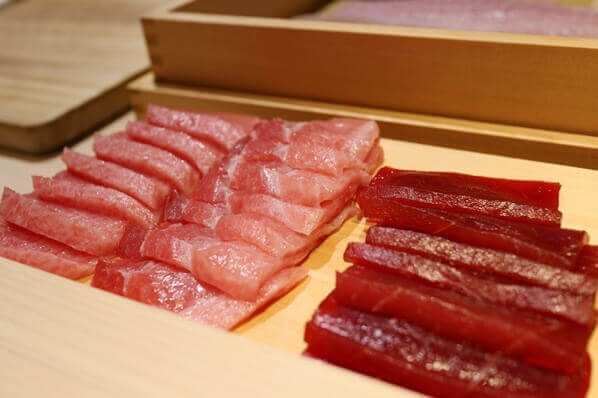For any business to prosper, it aims to sell its products at the highest possible price that customers are willing to pay. So how does a chef determine the price of nigiri sushi?
 Naturally, the cost price is what it costs the restaurant for the ingredients while the price on the menu is the selling price. The ratio between these two is called the “cost ratio.” In the case of a sushi restaurant, the ideal cost rate is 35% or less. A restaurant operating with only Omakase will have a cost rate of 40% with a focus on the quality of the toppings.
Naturally, the cost price is what it costs the restaurant for the ingredients while the price on the menu is the selling price. The ratio between these two is called the “cost ratio.” In the case of a sushi restaurant, the ideal cost rate is 35% or less. A restaurant operating with only Omakase will have a cost rate of 40% with a focus on the quality of the toppings.
For sushi restaurants, handling of this ratio and the yield are very important. Yield refers to the part of the purchased fish and shellfish that can actually be used. For example, when purchasing a whole fish there are bones, skin, eyes, tail and internal organs that cannot be served as sushi or sashimi. Even the most skilled chef cannot eliminate bones or skin. In other words, the yield rate is the percentage of parts that can be used as sushi or sashimi. Typical fish yield rates are as follows:
Wild Maguro (Tuna): 65~75%
Buri (Japanese amberjack): 50%
Hirame (Bastard halibut): 40%
Tai (Red seabream): 35%
Akagai (Ark shell): 25%
The weight of just the topping for a single piece of nigiri sushi is 12 to 18 grams, depending on the ingredients and the policy of the restaurant. The market price for rice is said to be about US$5 per kilogram, and assuming a weight of 15 grams per Nigiri, the rice for a piece of sushi is generally said to cost about US$0.05, including vinegar and salt. Even if you count the shari (sushi rice), soy sauce, wasabi, nori, etc., it’s fair to consider the cost to be about US$0.10.
Now, let’s figure out the price of Hirame, for which 3 kilograms were bought at $60 per kilogram. Assume that the weight of one topping is 15 grams.
The yield rate of Hirame is 40%, so the chef can make 1,200 grams of sushi toppings from 3,000 grams of Hirame. (formula: 3000 g × 0.4 = 1200 g). Since the weight of one topping is 15 grams, 80 pieces of sushi can be made from 3,000 grams of Hirame (1200 g ÷ 15 g = 80 pieces).
Next, we calculate the cost of one topping. Hirame is US$60 per kilogram, so US$180 (US$60×3 = US$180) for 3 kilograms. Since this volume can yield 80 pieces, the cost of one topping is US$2.25 (US$180÷ 80 pieces = US$2.25).
Add the shari price of US$0.10 to this: US$2.25+0.1=US$2.35. In other words, the cost of one Hirame nigiri sushi is US$2.35.
If the ideal cost ratio of 35% is applied here we get 2.35÷0.35 (35%) = US$6.71. For a restaurant serving mainly Omakase, 2.35÷0.4 = US$5.88.
In summary, one piece of Hirame sushi is sold between $5.88 and $6.71.
This may seem surprisingly affordable, but if you run the same calculation for kuromaguro (bluefin tuna) or uni (sea urchin), the price can reach US$60 to US$90 per piece—suddenly making it feel expensive. Therefore, the total margin is secured by setting the cost rate for Kuromaguro and Uni to 80-90%, while the cost rate for Saba and Ika is set to 10-20%.
In other words, a sushi restaurant does not determine the price of each piece in isolation. Instead, it balances profitability across the entire menu. Expensive items such as kuromaguro or uni are often sold at a high cost ratio, sometimes close to break-even, because they attract customers and enhance the restaurant’s reputation. On the other hand, more affordable ingredients like saba or ika are priced at a lower cost ratio, which helps support the overall profit margin. This cross-subsidization allows the restaurant to offer both luxury toppings and everyday favorites while maintaining sustainable business operations.
At the same time, the price of sushi is not determined by cost calculations alone. Factors such as the restaurant’s reputation, location, and the value customers perceive in the dining experience also play a decisive role. A well-established sushi restaurant in a prime location can charge higher prices for the same piece of nigiri than a small neighborhood shop, because guests are willing to pay not only for the sushi itself but also for the atmosphere, craftsmanship, and prestige that come with it.
[sc_apply url=”https://sushiuniversity.jp/apply/”]
We hope this information will be helpful.

Revision date: September 3, 2025
Share this article
It’s crazy reading this article! I live in Japan and the price of sushi is so different here. Most Nigiri are as cheap as $.42 (¥50) a piece at many sushi restaurants here. You can get many different varieties at that price too, it’s not just the cheap stuff like Tuna. What a time to be alive